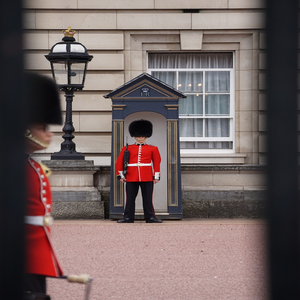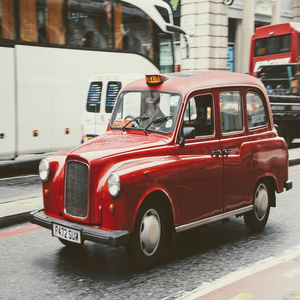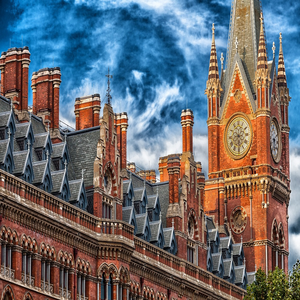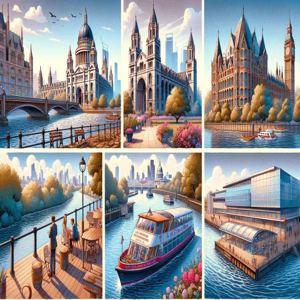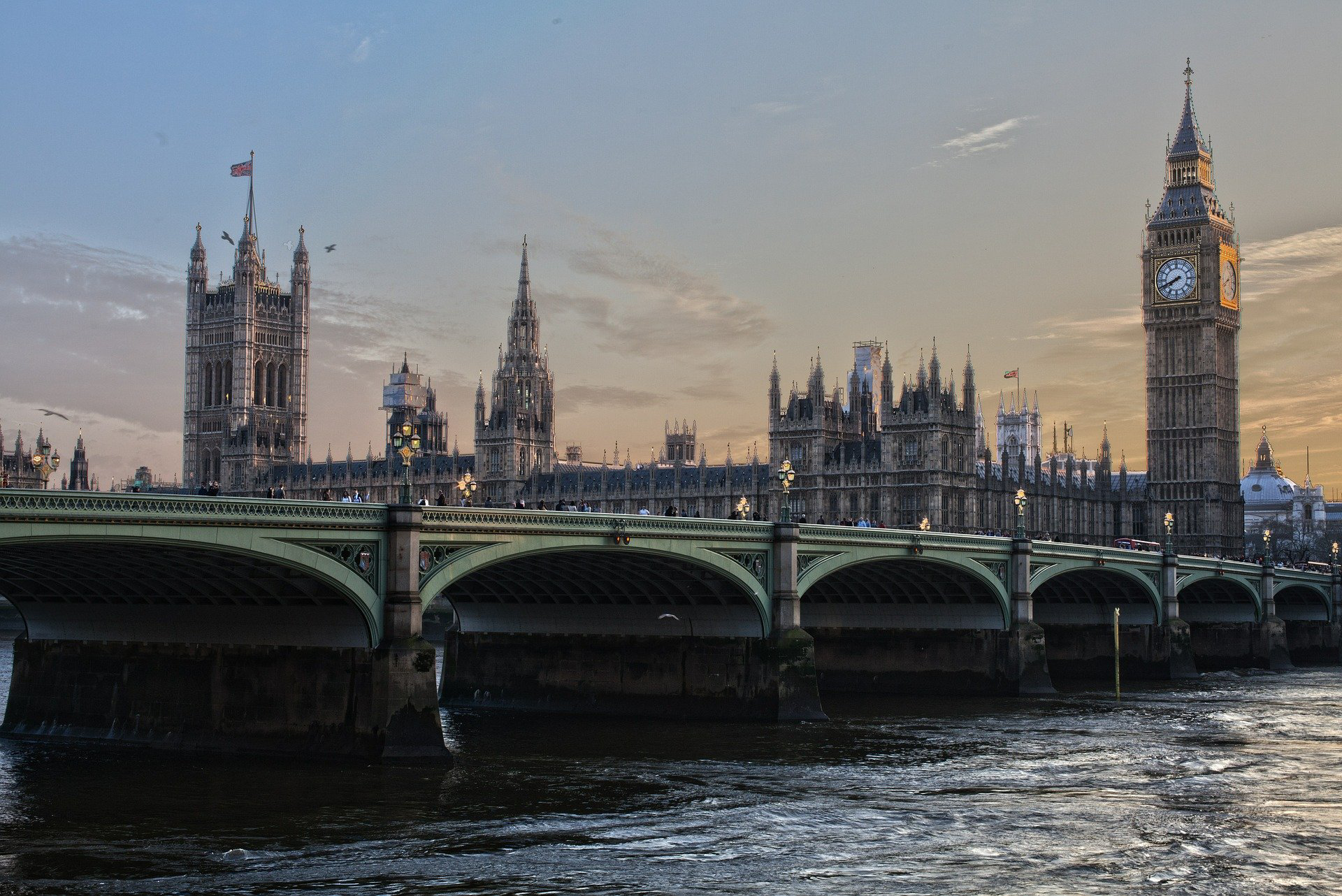
London Attractions
The capital of Great Britain, a city of great historical significance and interest and a stronghold of English traditions, London is the most popular destination for the British "excursion." Seeing the dramatic royal guards, hearing Big Ben chime, feeding the ravens in the Tower, and surveying the City from the London Eye are the must-do activities for the capital's sightseers (as is the traditional "Friday drink" in overcrowded Soho pubs).
There are always more surprises in one of the greenest capitals in Europe, where each district has its park or even several. On the way to Trafalgar Square, you can find yourself in India or Chinatown. Suddenly you enter a hipster market: an alley lined with shops, strange clothes, and comics in a tourist center, somewhere in Westminster or South Camden.
With so much to see, don't miss some of the most exciting attractions in London like The Tower of London and the Crown Jewels, a River Thames cruise, The London Eye, St. Paul's Cathedral, Buckingham Palace, Kew Gardens, Little Venice: Regent's Canal Waterbus Boat Trip to Camden. If situated in London, highly recommended trips outside the City would be a tour to the Cotswolds, Stonehenge, Windsor Castle, and Oxford University.
Not enough? Here's another reason for you: many fascinating museums with free admission.
Not enough? It is worth a visit just because London is the birthplace of Sherlock Holmes.
Is this not enough? Then - read it by letter: there is always a delicious beer in London!
"Excuse me, where is Big Ben?"
The city metro is divided into zones:
Inner London is in the central circle of zones 1-2.
The next circle (zones 3-4) already covers several dozen areas, including "sports famous" to the whole world Wimbledon and Wembley, Greenwich ("the capital's sea gate," the only remote area where there are enough monuments for a full day of inspection), Tottenham and other.
The last circle of zones 5-6 encircles Greater London; this includes the nearest suburbs and Heathrow Airport. Here it is concentrated in "the same London."
So, there are three historical centers (in Inner London, of course, since most of the Outer London remained in forests and swamps until the beginning of the 20th century) from where the City grew
. On the left, north, Thames. On the right - Southwark, Westminster, and the City connected to them by the Tower Bridge (no epithets: we reverently walk, look, blown away by a heavy wind). The city center on the north bank has almost no monuments preserved before 1666, the year of a grandiose fire. The southern coast generally saved only a few ancient monuments and left great memories for itself.
City and Tower Hamlet
In the City, London appears gloomy and majestic ( the bulk of St. Paul's Cathedral, St. Bridge Church) and office and modern: the skyscrapers of Broadgate Tower, St. Mary Ax, etc., are added to it. In both areas there is not much housing for tourists, apartments predominate. Such rooms or apartments quickly disperse.
Westminster
West of the City is another historic center, Westminster; busy and in places much less neat. It occupies a vast territory (from Camden in the north to the Thames in the south), includes the most famous city parks (Green Park, Hyde Park, Holland Park, Kensington Gardens, Regent's Park, and St. James's Park) and the most prestigious quarters, which are sometimes called separate areas: Belgravia, Covent Garden with its line of theatres, Soho, Mayfair, Marylebone. It is useless to list all the sights of Westminster: Trafalgar Square, the royal residence at Buckingham Palace, the Houses of Parliament with its Big Ben, Westminster Abbey, and Tate Gallery. This is another London from the cover. Most touristy streets: Whitehall, Baker Street, Oxford Street, Drury Lane, Piccadilly, Fleet Street
At the same time, winding along the poorly lit alleys around the Royal Opera House (like the quarter, the theatre is called Covent Garden ), you risk getting into a puddle of suspicious origin with both feet. Or, leaving a store on one of the main streets, step on a homeless person who will sleep for the night, wrapped in a sleeping bag, right under his windows.
There are many hotels in Westminster; you can find a more or less decent option with hard work.
Camden
North of the City and Westminster stretches Camden - an area that must be seen to fall in love with London. After the crowds in Westminster, it breathes deeply here - it is a calm, respectable, historical (south side, Bloomsbury), green area. Many squares were laid out instead of parks in the Georgian era (Queen Square, Russell Square, Fitzroy Square, Bloomsbury Square, and Bedford Square). And the square-park Lincoln's Inn Fields on the border with Westminster is considered the prototype of Central Park in New York.
Here, in the British Museum, one of the most significant collections of antiquities in the world is kept, and most of the faculties of the University of London are concentrated in Camden. The King's Cross station complex, from the non-existent platform of which the train to Harry Potter University departed, is also located in Camden. As in other parts of London, the buildings of the 18th and 19th centuries alternate with skyscrapers and residential areas. It is also a district of London-style markets: with an abundance of cheap souvenirs, simple food, and youth clothing of a controversial look and quality but exceptionally cheerful.
Settling somewhere in Bloomsbury, you can visit the British Museum almost daily and take walks in Westminster and the City. However, many chain hotels are here, so the average price tag is relatively high.
In other areas of Inner London on the West Bank of the Thames, we will see primarily respectable residential areas with low-rise buildings, modern theatres, parks, the world-famous stadiums of London football clubs, shopping centers, and many restaurants. Hotels here are much cheaper because you can't get to the main attractions on your own two feet.
South coast
There are fewer sights in Inner London on the other side of the Thames; they are mainly located across the river from the Tower - in Lambeth: The Eye of London, Waterloo Station, and the central public gardens of the empire in the 17-19 centuries Vauxhall Gardens, Shakespeare's Globe Theater, medieval City Cathedral, Imperial War Museum. Thrifty tourists also prefer to settle here - the more profound to the north, the more economical.
London cannot be called a safe city for tourists. So, guides always advise to be careful and not to meddle in the quarters of Outer London. On the other hand, you are even more at risk from pickpockets and phone thieves (thefts are expected when the phone is snatched at the subway exit - in the area where it starts to pick up a signal).
Even more to beware of public transport. Suppose London motorists watch the road and pedestrians. In that case, the drivers of the famous double-decker buses make dangerous maneuvers at crowded intersections during the day and dashingly drive at night. Therefore, at night, the road in the center should be crossed only when you are convinced that not a single "red" loom on it.
London's Accessibility for people with disabilities and seniors
London continues to improve Accessibility for travelers. The City's inclusive design, such as step-free access, ramps, and smooth surfaces, ensures that visitors can quickly access the capital's transport network, top sights, and accommodation.
Inclusive for all London transportation
London Underground trains
The London Underground network offers incredibly accessible facilities and step-free access. However, not all London Tube stations are fully accessible, so check the Transport for London (TfL) journey planner before you travel.
More than 60 Tube stations offer step-free access for wheelchair users, with Tube-level platforms and manual boarding ramps.
Tactile markings on many platform edges, contrast-color station facilities for visually impaired travelers, audiovisual announcers, and information points at most stations. The Victoria, Metropolitan, Circle, District, and Hammersmith & City lines all have highly accessible Tube trains.
TfL offers a range of accessible travel guides for use during your trip:
- Audio Tube map
- Tube tunnels map [PDF 1.35MB]
- Large-print Tube map [PDF 779KB]
- Step-free Tube map [PDF 658KB]
- Tube map for avoiding stairs [PDF 452KB]
- Colour-blind-friendly maps [PDF 555KB]
- Accessible-toilet map [PDF 299KB]
London Overground and trains
of TfL's London Overground services provide accessible facilities for disabled passengers, including audiovisual information, wheelchair ramps, wide-access doors, and grab rails. Helpful staff is available to assist with your journey, and registered assistance dogs are permitted to travel on all Overground London trains.
If you're planning to travel to London via an alternative train operator, read National Rail Enquiries' information for disabled passengers, which provides accessibility guidance, including travel assistance, station facilities, and discounted fares.
Tube-free London transport
London buses
There are accessible buses across 700 London bus routes, all fitted with low-level floors, wheelchair ramps, and audiovisual announcers. Wheelchair users can travel free of charge on all Transport for London buses, and registered assistance dogs are also welcome on board.
Docklands Light Railway (DLR)
The Docklands Light Railway (DLR) is one of London's most accessible forms of public transport, with level access for wheelchair users and elevators or ramps to platforms at all stations. It also aids include tactile marking, wheelchair bays, audio, visual announcements, and assistance animals are permitted to travel onboard.
River buses
You can enjoy sailing down the Thames on a river bus. Most piers offer disability-friendly platform access for people in wheelchairs, and plenty of services provide wheelchair toilets and ramps.
Thames Clippers' boats are disabled-friendly, with audio narration, inclusive of all toilets, and visual information available at the pier. Assistance animals are also permitted.
You can enjoy a sightseeing cruise with iconic attractions such as the London Eye, Big Ben, and Tower Bridge with City Cruises, which offers a 50% discount on tickets for wheelchair users and one friend. At the same time, blind passengers travel free of charge.
Wheelchair friendly London trams
London trams are highly accessible, with priority seating for disabled and elderly passengers, level access on the platform, wheelchair-accessible buttons, and an emergency intercom system to contact the driver for assistance. Travel is free of charge for wheelchair users, and there are tactile markings along the platform edge for visually impaired visitors to London.

0$
0$
3000$

Likely to Sell Out
Price From
$123.76
See an official residence of The King and home of the British monarchy for more than 900 years*, explore the beautiful Georgian city of Bath and its ancient Roman Baths*, and uncover the mystery behind Stonehenge - the world's most famous Neolithic site.
Learn More
Likely to Sell Out
Price From
$128.97
Explore the beautiful scenery of the English countryside on this full-day tour of Windsor, Stonehenge, Lacock and Bath. Head to Windsor, home of the British Royal Family famous for Windsor Castle. Over 900 years of royal history are waiting for you there. Continue onward to the 5,000-year-old prehistoric site of Stonehenge with a guide, and ponder over its use in centuries past. Visit the charming English village of Lacock for a traditional pub lunch, and finally, enjoy a coach tour of Georgian city of Bath as well as a short walking tour.
Learn More
Likely to Sell Out
Price From
$23.77
For 2 hours, your tour guide will whisk you away on a magical adventure to explore the Harry Potter movie locations in London. Uncover places that inspired J. K. Rowling and hear about the weird and wonderful behind-the-scenes stories.
You will be led in small groups of a maximum 20 people as you cover some London landmarks passed on the tour as a little bonus.

Likely to Sell Out
Within the ancient Fortress, the Tower of London, visitors can gaze up at the imposing White Tower and marvel at the priceless Crown Jewels. Hear bloody tales of the Tower told by the Yeoman Warders; stand where famous heads rolled and discover where prisoners and exotic animals including a polar bear were kept.
Visit the Royal Armouries Line of Kings display, the world's longest running museum exhibit, in the iconic White Tower.
Complete your visit on the Tower Wharf overlooking the river Thames, Tower Bridge and Europe's tallest skyscraper, The Shard.
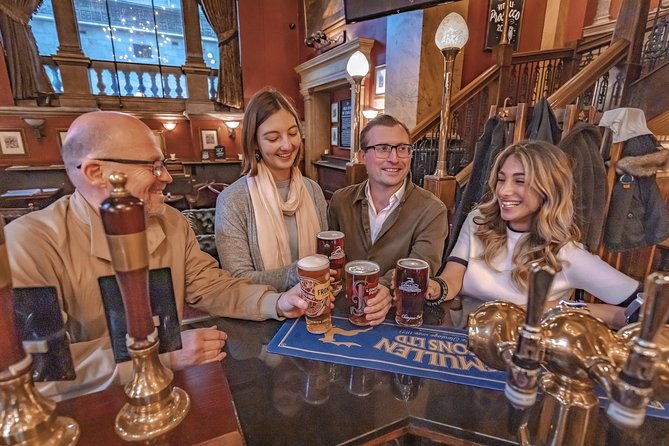
Likely to Sell Out
Price From
$32.57
Discover ancient ale houses and literary drinking dens on a 3-hour afternoon pub tour of London. Centered on the area in and around the City of London, the tour visits at least four of London’s finest historical pubs, your guide will recommend different ales in each (not included). Hear the history of the pubs, learn the differences between Elizabethan coaching inns and Victorian gin palaces, and visit the watering holes frequented by legendary British novelist Charles Dickens. Numbers are limited to 14 on this small-group pub tour, ensuring you’ll enjoy personalized attention from your guide.
Learn More
Likely to Sell Out
Price From
$69.07
Fast Track for a perfect London Eye experience! With fast track entry for your flight in a shared capsule, you get to skip the majority of the queue. Don't waste time waiting in lines on vacation! The London Eye offers spectacular views of the capital of England from high above the River Thames. The famous landmarks to be seen include Big Ben and the Houses of Parliament, St. Paul's Cathedral, Buckingham Palace and Westminster Abbey. Visit includes entry to the London Eye 4D Experience, an inspiring journey of discovery that brings London to life through multi-sensory special effects.
Learn More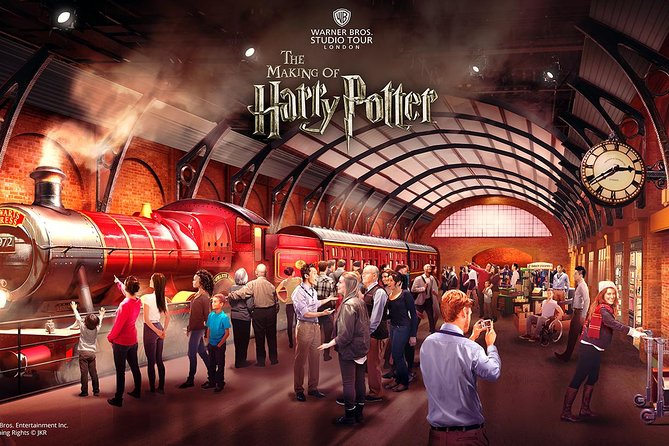
Likely to Sell Out
Price From
$138.11
Delve into the magical world of Harry Potter™ at the Warner Bros. Studio Tour London, with round-trip luxury coach transport included. Follow in the footsteps of Hogwarts’ students as you walk around original sets like Diagon Alley and Platform 9 ¾, complete with the Hogwarts Express steam engine. Get up close to costumes and props, and discover the wizardry required to create the mind-blowing special effects and animatronics.
MAGICAL MISCHIEF: Until 18th April 2023:
Returning for a second year, filmmaking trickery, magical pranks and wizarding mishaps will be revealed as part of the Studio Tour’s Magical Mischief feature.
DISCOVERING HOGWARTS: 2nd May - 4th September 2023:
For the first time since filming, over 400 floating candles will adorn the enchanted ceiling of the Great Hall, giving visitors a chance to step into the set just as the cast would have seen it during Harry Potter and the Philosopher’s Stone.

Likely to Sell Out
Price From
$42.33
Be part of London’s skyline!
The London Eye offers spectacular views of the capital of England from high above the River Thames. The famous landmarks to be seen include Big Ben and the Houses of Parliament, St. Paul's Cathedral, Buckingham Palace and Westminster Abbey.
But it is more than just the view. t’s about unforgettable memories and every year The London Eye play host to millions of them.
Visit includes an entry to the London Eye 4D Experience, an inspiring journey of discovery that brings London to life through multi-sensory special effects.




Price From
$6.50
320 tours and activities
Access for Visually Impaired
Accessibility for wheels
Access for Seniors
For Individuals with Hearing Loss

Price From
$23.42
482 tours and activities
Access for Visually Impaired
Accessibility for wheels
Access for Seniors
For Individuals with Hearing Loss

Price From
$22.85
608 tours and activities
Access for Visually Impaired
Accessibility for wheels
Access for Seniors
For Individuals with Hearing Loss

Price From
$19.54
244 tours and activities
Access for Visually Impaired
Accessibility for wheels
Access for Seniors
For Individuals with Hearing Loss

Price From
$27.62
695 tours and activities
Access for Visually Impaired
Accessibility for wheels
Access for Seniors
For Individuals with Hearing Loss

Price From
$19.54
631 tours and activities
Access for Visually Impaired
Accessibility for wheels
Access for Seniors
For Individuals with Hearing Loss

Price From
$35.17
617 tours and activities
Access for Visually Impaired
Accessibility for wheels
Access for Seniors
For Individuals with Hearing Loss

Price From
$29.66
333 tours and activities
Access for Visually Impaired
Accessibility for wheels
Access for Seniors
For Individuals with Hearing Loss

Price From
$6.66
719 tours and activities
Access for Visually Impaired
Accessibility for wheels
Access for Seniors
For Individuals with Hearing Loss


London, like other major cities, has made an effort to improve accessibility for people with disabilities (PWD) and seniors. Here is some detailed information about the accessibility options available in London:
1. Public Transport: London has an extensive public transport system with accessible options for PWD and seniors. Almost all tube stations have step-free access and wide gates to accommodate wheelchairs and mobility scooters. Buses are equipped with ramps, and TfL has trained staff to assist those needing extra help. The TfL website has a detailed guide for all the accessible services available. Additionally, the Blue Badge scheme allows disabled drivers to park in designated parking spots.
2. Roads and Pavements: London does not lack in accessibility options on its roads and pavements. Drop-down kerbs, tactile paving, and pedestrianised streets make it easier for PWD and seniors to navigate in the city.
3. Accessible Attractions: Many London attractions have made provisions for PWD and seniors. The Tate Modern, the British Museum, and the National Gallery have wheelchair access, tactile information boards, and audio descriptions for the visually impaired. Some of London’s iconic landmarks also offer accessible options like the London Eye, which has accessible capsules, and the Tower of London, which allows disabled visitors to access the Crown Jewels.
4. Accommodation: Many hotels are equipped to accommodate PWD and seniors. Several hotels in central London have rooms that are wheelchair-friendly, have grab rails, and also provide other accessibility services.
5. Services for People with Disabilities: There are various organisations that provide support for PWD and seniors. For instance, the London Mobility Centre provides free assessments for people with mobility issues to find equipment to suit their requirements. The Royal National Institute of Blind People has a centre that offers advice, information, and training services for the visually impaired.
In conclusion, London’s accessibility options cater to PWD and seniors. The city has worked towards making it easier for everyone to navigate and enjoy its offerings. However, there is much room for improvement. Londoners and visitors should continue to highlight areas needing improvement to create a more inclusive city.
City Info and Accessibility
London Safety Tips:
1. Be cautious of pickpockets, especially in crowded tourist areas and on public transportation.
2. Keep your belongings secure and be aware of your surroundings at all times.
3. Be cautious when crossing the street and always look both ways, as traffic in London drives on the left side.
4. Avoid walking alone in poorly lit or unfamiliar areas at night.
5. Stay updated with local news and follow any safety advisories.
Common Languages Spoken:
1. English is the primary language spoken in London.
2. Due to its diverse population, you may also hear other languages such as Bengali, Polish, Punjabi, Arabic, Urdu, and more.
Best Travel Seasons:
1. The best time to visit London is during the spring (March to May) and autumn (September to November) when the weather is mild and the crowds are thinner.
2. Summer (June to August) is also a popular time to visit, but be prepared for larger crowds and higher prices.
3. Winter (December to February) can be cold and damp, but you can experience festive events and holiday decorations.
4. Consider avoiding the peak tourist season of July and August if you prefer to explore London without the large crowds.
 Public Transport Accessibility
8/10
Public Transport Accessibility
8/10
 Airport Accessibility
9/10
Airport Accessibility
9/10
 Common Accessibility
8/10
Common Accessibility
8/10
London is a vibrant and diverse city with a plethora of accommodation options to suit every budget and preference. Here are some of the best areas to stay in London:
1. Covent Garden: Known for its buzzy atmosphere, street performers, and proximity to the West End theaters.
2. South Bank: Offers stunning views of the Thames River and is home to iconic attractions like the London Eye and Tate Modern.
3. Mayfair: A luxurious neighborhood with upscale hotels, high-end shopping, and fine dining options.
4. Notting Hill: Famous for its colorful houses, trendy boutiques, and the Portobello Road Market.
5. Shoreditch: A hip and edgy area known for its artistic vibes, street art, and vibrant nightlife.
When it comes to accommodation options in London, there is something for everyone:
1. Budget: Hostels, budget hotels, and Airbnb rentals are great options for those looking to save money. Areas like Kings Cross, Victoria, and Paddington have a wide range of budget accommodation options.
2. Mid-range: Chain hotels like Premier Inn, Travelodge, and Holiday Inn Express offer comfortable rooms at affordable prices. Look for hotels in areas like South Kensington, Bloomsbury, or Canary Wharf.
3. Luxury: London has no shortage of luxurious hotels catering to those looking for a high-end experience. The Ritz, The Savoy, and The Dorchester are just a few examples of iconic luxury hotels in the city.
For seniors and individuals with disabilities, London offers a range of accessible accommodation options:
1. Many hotels in London offer accessible rooms with features like grab bars, roll-in showers, and wider doorways to accommodate guests with disabilities.
2. Airbnb also has a selection of properties with accessibility features such as step-free access, wheelchair ramps, and elevators.
3. Some hotels specifically cater to guests with disabilities, such as the Park Plaza Westminster Bridge London, which offers accessible rooms with adapted bathrooms and facilities.
Overall, London provides a variety of accommodation options for visitors of all ages and abilities, ensuring that everyone can find a place to stay that meets their needs and preferences.
There are several transportation options available in London to help you navigate the city efficiently:
1. **Airport Transfers**:
- **Heathrow Airport**: The Heathrow Express train provides a fast and convenient connection to central London. Alternatively, you can take the London Underground (Piccadilly Line) or a taxi.
- **Gatwick Airport**: The Gatwick Express train offers a direct connection to Victoria station. Buses and taxis are also available for transportation to central London.
- **Stansted Airport**: The Stansted Express train connects the airport to Liverpool Street station. National Express buses and taxis are also available.
- **Luton Airport**: The Thameslink train service connects Luton Airport to central London. Airport shuttles and taxis are also available.
2. **Public Transport**:
- **London Underground (Tube)**: The Tube is a quick and efficient way to travel around London. It consists of 11 lines that cover the city and its outskirts.
- **Buses**: London has an extensive bus network that covers all parts of the city. You can pay with an Oyster card, contactless payment, or cash.
- **Trams**: Trams operate in South London and are a convenient way to travel in that area.
- **Docklands Light Railway (DLR)**: The DLR serves East London and connects with the Tube network.
- **London Overground**: The Overground covers various parts of London and its suburbs.
3. **Senior and Disability Accessible Transportation**:
- **Freedom Pass**: The Freedom Pass allows older and disabled residents to travel for free on public transport in London.
- **Taxi and Private Hire Services**: London has several taxi and private hire services that cater to passengers with mobility needs. Some of these services are wheelchair-accessible.
4. **Navigating the City**:
- **Oyster Card**: The Oyster card is a convenient way to pay for public transport in London. You can top up the card with credit and use it across all modes of transport.
- **Google Maps**: Google Maps is a useful tool for navigating London’s public transport system. You can input your destination and it will provide you with the best route options.
- **Tube Map**: Familiarize yourself with the London Tube map to plan your journeys efficiently. Maps are available at all Tube stations and online.
- **Avoid Rush Hours**: To avoid crowded trains and buses, try to travel outside of peak rush hours (7:30-9:30 am and 5-7 pm).
London’s transportation network is well-connected and accessible, making it easy for residents and visitors to explore the city.
1. Visit the London Zoo: This iconic zoo is home to a wide variety of animals from around the world and offers interactive exhibits and activities for children.
2. Explore the Natural History Museum: This museum is not only educational but also entertaining for kids with its dinosaur skeletons, interactive exhibits, and hands-on learning opportunities.
3. Enjoy a day at the Science Museum: Another great museum for kids, the Science Museum offers interactive exhibits, live demonstrations, and hands-on activities that will keep children entertained for hours.
4. Stroll through Hyde Park: One of London’s largest and most famous parks, Hyde Park offers plenty of open space for children to run around, playgrounds, and even a lake where you can rent pedal boats.
5. Visit the Diana, Princess of Wales Memorial Playground: Located in Kensington Gardens, this playground is inspired by the adventures of Peter Pan and is a great place for children to play and explore.
6. Take a ride on the London Eye: This iconic Ferris wheel offers stunning views of the city and is a fun experience for the whole family.
7. Explore Greenwich Park: This historic park offers beautiful views of the city, a deer park, playgrounds, and the Royal Observatory where children can learn about astronomy.
8. Visit the London Transport Museum: This museum is perfect for little transport enthusiasts with its collection of historic buses, trains, and interactive exhibits.
9. Enjoy a boat ride on the River Thames: Take a scenic boat trip along the River Thames and see London from a different perspective.
10. Have a picnic in Regent’s Park: This beautiful park is a great spot for a family picnic, with playgrounds, boating lakes, and even an open-air theater.
London is a vibrant and diverse city with a wide range of cultural experiences to enjoy. Some of the must-see cultural attractions include the British Museum, the Tate Modern, and the Victoria and Albert Museum. These institutions house some of the world’s most significant art and historical artifacts.
In addition to its museums, London is known for its numerous festivals and events throughout the year. Notable festivals include the Notting Hill Carnival, one of Europe’s largest street festivals celebrating Caribbean culture, and the annual Pride in London parade, which celebrates the city’s LGBTQ+ community.
For those looking to explore hidden gems in the city, there are plenty of off-the-beaten-path attractions to discover. From the colorful street art in Shoreditch to the quaint cafes and boutiques in the neighborhood of Hampstead, London offers a wealth of hidden treasures waiting to be explored.
In terms of nightlife and entertainment, London is a city that never sleeps. From world-class theaters in the West End to trendy bars and clubs in Shoreditch and Soho, there is no shortage of options for a night out on the town. And for music lovers, London’s live music scene is second to none, with venues ranging from intimate pubs to iconic stadiums.
Overall, London offers a rich tapestry of cultural experiences, festivals, hidden gems, and nightlife options that cater to every taste and interest. Whether you’re a history buff, art enthusiast, or party-goer, there is something for everyone to enjoy in this bustling metropolis.
1. **Budget-Friendly Options:**
- **Dishoom:** Known for their affordable and delicious Indian cuisine.
- **Franco Manca:** Offers budget-friendly sourdough pizzas with a focus on high-quality ingredients.
- **Byron Burger:** A popular chain known for their affordable and delicious burgers.
- **Mildreds:** A vegetarian restaurant with budget-friendly options and a focus on seasonal ingredients.
2. **Fine Dining Options:**
- **Sketch:** A unique dining experience with multiple Michelin-starred restaurants under one roof.
- **The Ledbury:** A two Michelin-starred restaurant offering fine dining in Notting Hill.
- **Dinner by Heston Blumenthal:** A Michelin-starred restaurant with a focus on historic British gastronomy.
- **Core by Clare Smyth:** A Michelin-starred restaurant offering modern British cuisine in Notting Hill.
3. **Allergy-Friendly Options:**
- **Honest Burgers:** Known for their gluten-free options and allergy-friendly menu.
- **Niche:** A restaurant dedicated to catering for different dietary restrictions, including gluten-free, dairy-free, and vegan options.
- **Pollen Street Social:** A Michelin-starred restaurant with a knowledgeable staff that can accommodate various allergies and dietary restrictions.
- **The Gate:** A vegetarian and vegan restaurant with a wide range of allergy-friendly options on their menu.
4. **Dietary-Conscious Options:**
- **Farmacy:** A plant-based restaurant in Notting Hill with a focus on organic, seasonal, and locally-sourced ingredients.
- **Redemption:** A vegan and alcohol-free restaurant offering a range of healthy and delicious dishes.
- **Granger & Co:** Offers a variety of healthy and light options for breakfast, lunch, and dinner.
- **Gymkhana:** A Michelin-starred Indian restaurant with a dedicated vegetarian menu and options for various dietary preferences.
1. Currency Exchange: It is advisable to exchange your currency to British Pounds (GBP) at official exchange bureaus, banks, or ATMs to get the best rates. Avoid exchanging money at airports or hotels, as they often have higher fees.
2. Financial Tips: London can be an expensive city to visit, so it’s important to budget wisely. Take advantage of free attractions, use public transportation, and consider purchasing an Oyster card for discounted fares on buses and the underground.
3. Local Laws: Familiarize yourself with local laws and regulations while in London. It is illegal to drink alcohol in public places, and smoking is prohibited in enclosed public spaces. Always carry identification with you, as police officers may ask for it.
4. Customs and Etiquette: Londoners are generally polite and reserved. It is customary to greet people with a handshake or a simple \"hello.\" When dining out, it is customary to leave a tip of around 10-15% of the total bill.
5. Safety Advice: London is a relatively safe city, but it is important to take precautions to ensure your safety. Be cautious of pickpockets, especially in crowded tourist areas. Keep your belongings secure and be aware of your surroundings, especially at night.
6. Transportation: London has an extensive public transportation system, including buses, underground (Tube), trains, and black cabs. Consider getting an Oyster card for easy and affordable travel around the city.
7. Health and Emergency Services: If you require medical assistance while in London, dial 999 for emergency services. Make sure you have adequate travel insurance to cover any medical expenses.
8. Weather: London weather can be unpredictable, so it’s advisable to pack layers and a waterproof jacket. Check the weather forecast before heading out for the day.
9. Time Zone: London is in the Greenwich Mean Time (GMT) zone. Make sure to adjust your watches and schedule accordingly.
10. Language: English is the primary language spoken in London. However, you may come across different accents and dialects, especially in multicultural areas. It’s always helpful to learn a few common phrases and greetings.



